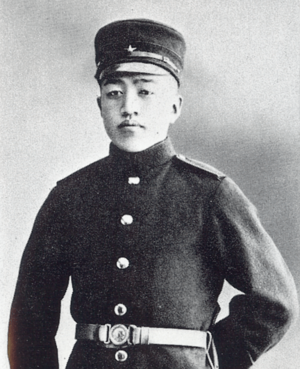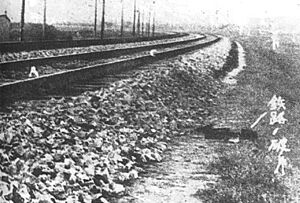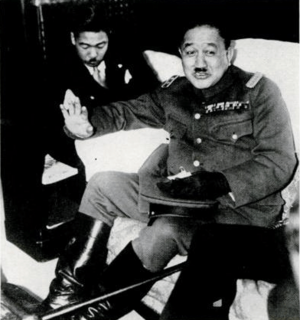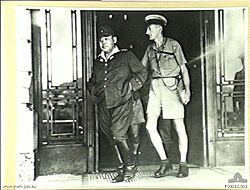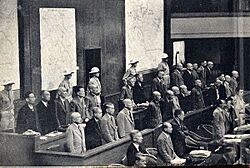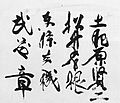Kenji Doihara facts for kids
Quick facts for kids
Doihara Kenji
|
|
|---|---|
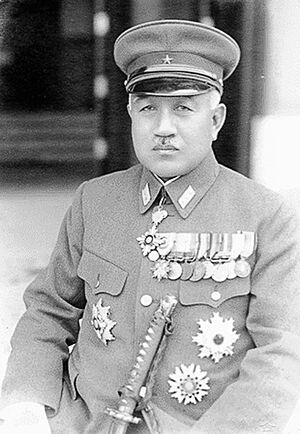
Doihara in c. 1941~45
|
|
| Nickname(s) | Lawrence of Manchuria, a reference to T. E. Lawrence |
| Born | 8 August 1883 Okayama, Japan |
| Died | 23 December 1948 (aged 65) Sugamo Prison, Tokyo, Occupied Japan |
| Cause of death | Execution by hanging |
| Allegiance | Empire of Japan |
| Service/ |
Imperial Japanese Army |
| Years of service | 1904–1945 |
| Rank | General |
| Commands held | 14th Division Fifth Army Seventh Area Army |
| Battles/wars | Siberian Intervention Second Sino-Japanese War World War II |
| Awards | Order of the Rising Sun |
Kenji Doihara (土肥原 賢二, Doihara Kenji, 8 August 1883 – 23 December 1948) was a Japanese army officer. He became a general in the Imperial Japanese Army during World War II. He played a very important role in Japan's plans to take over Manchuria, a region in China.
As a top intelligence officer, Doihara used secret plans to help Japan control large parts of China. He worked to weaken China and change its traditional way of life. He also supported many secret activities in areas of China that Japan had taken over.
After World War II ended, he was put on trial for his actions during the war. He was found responsible for serious wrongdoings and faced the highest penalty in December 1948.
Contents
Early Life and Military Career
Kenji Doihara was born in Okayama City, Japan. As a young person, he went to special schools that prepared him for a military career. In 1904, he finished his studies at the Imperial Japanese Army Academy.
He then served as a junior officer in different infantry (foot soldier) groups. Later, he went back to school and graduated from the Army Staff College in 1912.
Doihara spent most of his early career working in northern China. For a short time in 1921-1922, he was part of Japanese forces in eastern Russia during the Siberian Intervention. This was when Japan sent soldiers to Russia during its civil war.
He learned to speak Mandarin Chinese and other Chinese languages very well. This skill helped him get a job in military intelligence, which involves gathering secret information.
In 1928, from his intelligence role, he secretly planned the killing of Zhang Zuolin. Zhang Zuolin was a powerful Chinese leader who controlled Manchuria. Doihara planned to blow up Zhang Zuolin's train as it traveled. After this, Doihara worked as an advisor to the Chinese government until 1929.
In 1930, he became a colonel and led an infantry group. In 1931, he became the head of Japan's secret military operations in Tianjin, China. The next year, he moved to Shenyang to lead a special spy agency for the Japanese Kwantung Army.
The "Lawrence of Manchuria"
While in Tianjin, Doihara worked with another officer, Seishirō Itagaki. They planned a famous event called the Mukden Incident. Doihara ordered a bomb to be placed near train tracks. The bomb exploded as a Japanese train passed by. The damage was small, and the train was not hurt.
However, the Japanese government blamed the Chinese military for attacking them without reason. This event led to Japan invading and taking over Manchuria. During this invasion, Doihara helped Japanese generals work together.
Next, Doihara took on the task of bringing back Puyi, the last emperor of the Qing dynasty. The goal was to make it seem like Puyi returned to Manchuria because the people wanted him back. This would make Japan's control of the area look more rightful. Japan wanted to pretend it had nothing to do with Puyi's return.
To make this plan work, Puyi had to arrive in Yingkou before the port froze in mid-November 1931. Doihara got help from a famous spy named Kawashima Yoshiko. She knew the Emperor well. With her help, Doihara successfully brought Puyi to Manchuria on time.
In early 1932, Doihara was sent to lead another special agency in Harbin. There, he started talks with General Ma Zhanshan. Ma had been forced out of Qiqihar by the Japanese. Ma's position was unclear; he kept talking while also supporting General Ding Chao in Harbin.
When Doihara realized his talks were not working, he asked a Chinese leader, Xi Qia, to attack Harbin. But General Ding Chao defeated Xi Qia's forces. Doihara then realized he needed Japanese soldiers to succeed.
Doihara caused a riot in Harbin to give Japan a reason to step in. This led to Japanese soldiers coming from Mukden to help with the attack. Harbin fell on February 5, 1932. By the end of February, General Ding Chao retreated, and Chinese resistance officially ended.
Within a month, a new state called Manchukuo was set up. Doihara oversaw this process and even named himself mayor of Mukden for a short time. He then arranged for the new government to ask Tokyo for "military advice." In the following months, many Japanese soldiers, police, and secret police came to Manchukuo. Doihara used them to control the area. He forced the 30 million Chinese people there into harsh conditions.
General Ma Zhanshan was known for fighting against the Japanese. Doihara offered him a lot of money and command of Manchukuo's army if he would join the new government. Ma pretended to agree and flew to Mukden in January 1932. He attended the meeting where Manchukuo was founded and was made War Minister.
However, Ma used the Japanese money to create a new volunteer army. On April 1, 1932, he led his troops to Qiqihar. He restarted the Chinese government in that area and continued fighting against the Japanese.
From 1932 to 1933, Doihara was promoted to Major General. He led an infantry group. After Japan took over Rehe Province, Doihara went back to Manchukuo to lead the special agency again until 1934.
Because of his important role in Japan's takeover of Manchuria, he was called "Lawrence of Manchuria." This name referred to Lawrence of Arabia, a British officer who helped people gain freedom. However, some people felt this nickname was wrong because Doihara's actions were about controlling, not freeing, people.
Second Sino-Japanese War and World War II
From 1936 to 1937, Doihara was a commander in Japan. After the Marco Polo Bridge Incident in China, he was given command of the IJA 14th Division in North China. There, he took part in battles along the Beiping–Hankou Railway. He also led a campaign in Northern and Eastern Henan, where his division fought against a Chinese counterattack.
After this battle, Doihara worked for the Army General Staff until 1939. Then, he was given command of the Japanese Fifth Army in Manchukuo. In 1940, Doihara became a member of the Supreme War Council, a very important military group.
From 1940 to 1941, he was the head of the Imperial Japanese Army Academy. He then became the head of the Army's air force department and an Inspector-General for Army Aviation until 1943. On November 4, 1941, as a general and a member of the Supreme War Council, he approved the plan for the attack on Pearl Harbor.
In 1943, Doihara was made the top commander of the Eastern District Army. In 1944, he was appointed the Governor of Johor State in British Malaya (now Malaysia). He also became the commander of the Japanese Seventh Area Army in Singapore until 1945.
Returning to Japan in 1945, Doihara was promoted to Inspector-General of Military Training, one of the army's highest positions. He also became commander of the Japanese Twelfth Area Army. When Japan surrendered in 1945, Doihara was the commander of the 1st General Army.
Trial and Consequences
After Japan surrendered, Doihara was arrested by the Allied forces. He was put on trial before the International Military Tribunal of the Far East. This was a special court for people accused of serious war-related actions. He was found responsible for many wrongdoings and was sentenced to death. He faced the highest penalty on December 23, 1948, at Sugamo Prison.
Images for kids
-
Assassination of Zhang Zuolin, 4 June 1928
See also
- Japanese war crimes


